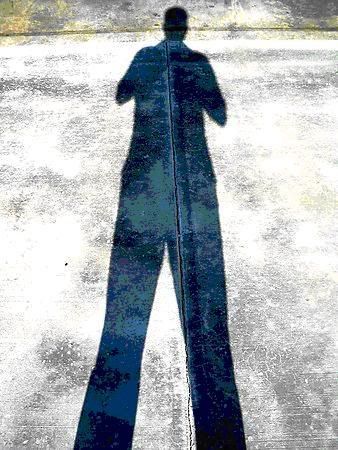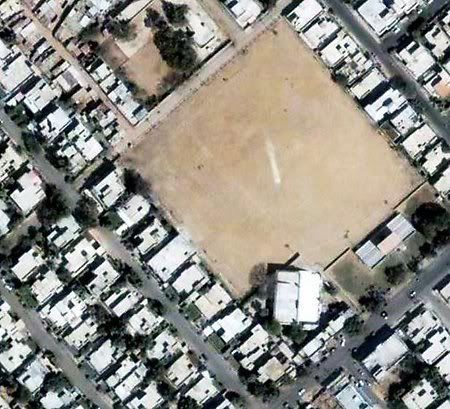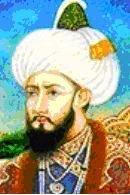The advent of Ramzan has reminded me of the following anecdote. Humayun (1508-1556), which we are all familiar with was son of King Babur and father of Emperor Akbar. If you want to know how Humayun looked like some 500 years ago in brisk colors then to the right of this text is an artist’s sketch.
“The” Humayun which we are going to discuss today is however nothing like above. He is son of Qureshi Saheb and father of none and he lived in our street during the period 1984-1994.
Before Humayun moved to our locality, I used to be the tallest boy in our street and had the laqab (title given by public) of Lamboo gali ka daada (i.e. The bully of the tall street).
I don’t remember how I got that laqab because those who know me can testify that I am anything but bully in real life.
In 1984, when Qureshi saheb’s family moved to our street, they also made sure to bring their son Humayun with them.  With a lean and extra thin physique, Humayun had a height of 6′ 4″ and from a distance he looked like a walking bamboo. I on the other hand was even slimmer than him and people called me a walking stick. Walking together we looked like the number 11. I don’t have a photo of Humayun so I took my own shadow photo in a setting sun shown to the left. This is how Humayun looked like in 1980s. Having few things in common i.e. height and extra slimness, Humayun and I became good friends.
With a lean and extra thin physique, Humayun had a height of 6′ 4″ and from a distance he looked like a walking bamboo. I on the other hand was even slimmer than him and people called me a walking stick. Walking together we looked like the number 11. I don’t have a photo of Humayun so I took my own shadow photo in a setting sun shown to the left. This is how Humayun looked like in 1980s. Having few things in common i.e. height and extra slimness, Humayun and I became good friends.
Jusy like me, he was a mad cricket fan. He was a very good fast bowler. Him and I used to open bowling for our mohalla (neighborhood) team. With the two of us from either end and with a variety of left arm (me) and right arm (him), we used to give tough time to any opposition batsman.
Besides cricket, Humayun had one more passion in life and that was an obsession to gain weight by any means. He would eat a lot of fats but to no avail. As long as I remember, his weight and width never increased.
We had an MBBS ‘Mian Bivi Bachon Samait’ (husabnd-wife-alongwith children) doctor named Dr. Masood living in our locality. Sometimes he would also come out to play cricket with us. Every now and then, Humayun used to ask his expert advice on how to gain weight. A typical conversation between the two went like this:
Humayun: “Masood bhai, kinnoo kha loon? kinnoo charbi to nahiN kaaTay ga?
(Brother Masood, Can I eat oranges? I hope it doesn’t cut into my fats)
Dr Masood: kha lo bhuee kha lo. charbi tum meiN hai kahaaN jo kattay gi?
(Go ahead and eat it. You don’t have any fats that could be cut into anyways)
At this Humayun would show his teeth and start peeling and eating another of his favorite kinnoo (a crossed variety of orange) in the street.
Some other things I remember about him include the episodes when we had to sit on a motorbike together. With pillion riding of a 6’4″ and a 6’2″ tall passengers, the motorcycle beneath us looked hilarious. From a distance it must’ve looked like two people sitting “ukRooN” (squatting) on the ground and somehow moving forward.
Humayun was also instrumental in the famous cricket incident where our team mysteriously disappeared without giving batting to the opposing team. To this day our opposing team has created lots of rumors about this particular game but let me tell you what actually happened. It was a 15-over-a-side Ramzan cricket tournament. One team used to bat before ‘namaz-e-asr’ (prayers) and second team after it. For one match we could only find 7 players. After winning the toss we elected to bat in a hope that we’ll miraculously find 4 missing players from some where. Those 4 players never showed up as nobody was willing to play empty stomach in sizzling Karachi heat. On the huge Shadab Cricket Ground in Gulberg we played full 15 overs like a test match and scored only 50-60 runs. Shadab Cricket Cricket (SCG) located in Gulberg Karachi is shown below. The building at one corner of the ground is Shadab masjid. Cricket pitch is also visible in the center of the ground.

With a taped-ball and only 7 fielders on our side, 50 runs would have been next to impossible to defend in a 15 over match. We were also playing under roza (fast) condition which made defending 50 runs look like a mountain. After molvi sahib said salam to the right hand side our whole team disappeared with from the left hand side door and went home. After the prayers the other team must’ve waited for their batting which they never got. We obviously lost the match because of walk-over given to other team but the enjoyment of ‘muffat ki’ (free) batting without having to field is still with me. Note my spellings of Urdu word ‘muft’ written deliberately as ‘muffat’ above. If instead of correctly pronoucing the word ‘muft’, you say it as ‘muffat’ then the enjoyment of getting something FREE doubles.
In 1994, Humayun family moved to North Nazimabad Karachi. I saw him for few more years here and there and whenever we played cricket together. I have lost contact with him for over 13 years now. Hopefully he is happy and prosperous wherever he is.
Photo Credits: First photo is from Wikipedia





















































Dear Alvipervaiz sahib, I hope my earlier message did not somehow offend you. I was certainly not expressing doubt at your explanation; rather, I find it quite compelling. I was merely expresing my own ignorance of it. When I say I had not heard of it, that is all I mean. That I had not heard of it. Nothing more.
I am also glad for your second message, in respose to Qalandar [I hope MQ does not mind my highlighting the Qalandariat than the Masti ;-) ]. I agree, architecturally, the Taj Mahal is indeed a masterpiece. I have visited it twice and admired its beauty and the craftsmanship of those who actually built it. My, and I think Sahir’s, issue is not with the building but with what – and who – it has come to symbolize.
ik shahenshah nay daulat ka sahara lay kar
hum ghareebouN ki mohabbat ka uRRaya hai mazaaq
So, my reaction is a mostly emotional one, not a purely aesthetic one; but decoupling the emotional from the aesthetic is never easy. I guess I am not fond of monarchs in general and particularly un-fond of this one; and of the sacrifices he made OTHERS pay for this monument. Others, of course, disagree (my sense is that MOST others disagree!).
Now on Jinnah’s mazaar. My reaction there is quite the opposite, but based on a similar premise. I actually try visiting it whenever I am in Karachi and am fond of it not because of the building but becasue of what (who) it stands for. Lets just say I like Mr. Jinnah much more than his mazaar. I don’t dislike it per se [and I do hope that my patriotism is not going to be measured by whether I do not not?]. Architecturally, I find it appealing, but probably it is not in the same league as the Taj, even if it is based on a similar structure. BTW, I think in recent years – as the grounds around it have blossomed and been taken care of – it has developed a more distinct character and sense of import than it had when it stood, quite literally, in the middle of ‘raRRh maidan’.
By the way, all of this gives me the idea that maybe we should do a seperate post inviting readers to talk about the buildings they like in Pakistan. That may throw up some interesting ideas.
“Do I discern an accusatory tone in your above statement?”
No Mast, if I may call you that, there is no accusation here. Liking and disliking of any piece of art and architecture is a matter of personal taste even though there are certain principles that most masters will agree on. All three pieces pointed out by you have some architectural value to them. It has nothing to do with the Empress, Jinnah or Patriatism. We are only speaking of architecture here.
[quote comment=”3644″]”Now don’t tell me you do not like the Jinnah’s mausoleum either.” ]
ALVIPERVAIZ,
Do I discern an accusatory tone in your above statement? There are many who don’t like Jinnah’s mausoleum for architectural reasons just like there are many (myself included) who don’t like Minar-e-Pakistan for similar reasons. But that has nothing to do with their feelings for Jinnah or their patriotism.
Now that you mentioned it, Jinnah’s mausoleum does look somewhat like Taj Mahal in that it shares some architectural elements with the latter.
The origin of the word Taj Mahal is interesting and it does sound plausible. It never occured to me even though it’s so obvious and likely. Thanks for this useful piece of information.
Dr. Najam: Classical Hindi, Bengali or even Punjabi lack the sounds of letter Z. It is very often substituted by the sounds of letter G or J. I learned that as a child when our unschooled house maid could not properly pronounce my name and used to call me ‘Pervaij’. She would also pronounce ‘Mumtaz’ as ‘Mumtaj’. It is just like the lack of sound of letter P in Arabic. Therefore Parsi in Persian becomes Farsi in Arabic. I am sure you have heard of this Arabic man who barked his car in a bark long enough to have a bicnic. Indeed Taj comes from Mumtaj by the locals unschooled in Persian, Arabic and Turkish. With all due respect to you and Sahir, the mausoleum remains an important piece of architecture. You may like to know that Jinnah’s mausoleum in Karachi is a simplified no-frill version of the Taj Mahal building in Agra. Both buildings have essentially the same architectural and structural elements. Now don’t tell me you do not like the Jinnah’s mausoleum either. Respectfully. AlvipervaiZ.
Dear AlviPervaiz, thank you for that comment. Intrigued and amused by teh ccomment on Taj Mahal. As I have written elsewhere , I am not much of a fan of the Taj Mahal for reasons that Sahir Ludhianvi had explained better than me. However, if it is correct that the TAJ came about becasue of the vernacularization of MumTAZ then, at least for me, the building just became that much more interesting! So, did it really?